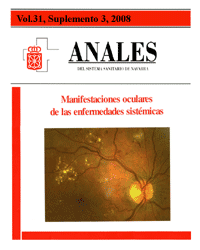Metástasis coroideas
Palabras clave:
Carcinoma. Melanoma. Hemangioma coroideo.Resumen
Las metástasis uveales son el tumor intraocular maligno más frecuente y de ellas, más del 80% se localizan en la coroides. Esto, unido al progresivo aumento de la incidencia, hace necesario su estudio y revisión para un correcto diagnóstico y tratamiento en la práctica clínica actual. La etiología varía según el sexo del paciente, siendo el carcinoma de pulmón el que con más frecuencia metastatiza en el varón y el de mama en la mujer. Tienden a la multifocalidad y generalmente se localizan en el polo posterior. En el 50% de los casos cursan de forma asintomática, pero pueden producir pérdida de visión, escotomas, metamorfopsias, y fotopsias. La exploración oftalmoscópica característica muestra una lesión coroidea placoide, homogénea y de aspecto cremoso. En el diagnóstico diferencial se debe considerar el nevus amelanótico, el melanoma amelanótico de coroides, el hemangioma coroideo, la escleritis posterior, el osteoma de coroides, las coriorretinitis, la enfermedad de Harada, el desprendimiento de retina rhegmatógeno, el síndrome de efusión uveal, y la coriorretinopatía serosa central. Una exhaustiva anamnesis y exploración oftalmológica completa son imprescindibles para el diagnóstico, a lo que se pueden añadir como pruebas complementarias la angiografía con fluoresceína, la ecografía ocular, la punción-aspiración con aguja fina (PAAF), la tomografía computarizada y la resonancia magnética. El tratamiento de estos tumores suele ser el tratamiento sistémico del tumor primario; las posibilidades de tratamiento local son la observación, la radioterapia externa, la braquiterapia, la termoterapia transpupilar y la enucleación.Descargas
Descargas
Publicado
Cómo citar
Número
Sección
Licencia
La revista Anales del Sistema Sanitario de Navarra es publicada por el Departamento de Salud del Gobierno de Navarra (España), quien conserva los derechos patrimoniales (copyright ) sobre el artículo publicado y favorece y permite la difusión del mismo bajo licencia Creative Commons Reconocimiento-CompartirIgual 4.0 Internacional (CC BY-SA 4.0). Esta licencia permite copiar, usar, difundir, transmitir y exponer públicamente el artículo, siempre que siempre que se cite la autoría y la publicación inicial en Anales del Sistema Sanitario de Navarra, y se distinga la existencia de esta licencia de uso.








